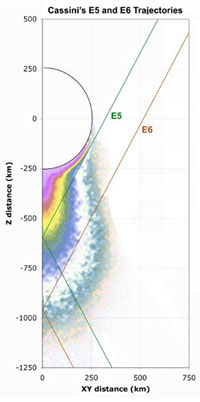 Todd Barber
Todd Barber
Cassini Lead Propulsion Engineer (bio)
Hello again from the realm of Cassini engineering, just 48 hours before another wonderful date with destiny! It is a distinct pleasure to kick off yet another Enceladus flyby blog, particularly one about a flyby so thrilling and daring. I’m happy to report the spacecraft is right on target for this historic encounter with Saturn’s icy and active companion. As an engineer, I think I’m most floored by the closest approach distance of 25 kilometers, roughly 16 miles. Cassini hasn’t been this close to any solid body since our ascent in a pre-dawn October sky in Florida in 1997! To further put this flyby in perspective, one can convert the minimum altitude into feet–yes, we’ll actually be that close! In this system of units, we will buzz this active water-geyser surface at only 82,000 feet, which puts Cassini closer to Enceladus (900 million miles from Earth, mind you) than an SR71 Blackbird can fly above the ground on the third rock! Wow!
 Given this truly up-close-and-personal flyby, the primary scientific focus will be “sniffing” the tenuous atmosphere of Enceladus, a rarefied collection of gas and dust spewed forth from a surprisingly active surface. As such, E5 will concentrate less on imaging results, but E6 will tip the scales towards imaging yet again, all before the end of the month. Truly, Cassini is embarking on a busy October for the ages!
Given this truly up-close-and-personal flyby, the primary scientific focus will be “sniffing” the tenuous atmosphere of Enceladus, a rarefied collection of gas and dust spewed forth from a surprisingly active surface. As such, E5 will concentrate less on imaging results, but E6 will tip the scales towards imaging yet again, all before the end of the month. Truly, Cassini is embarking on a busy October for the ages!
From the spacecraft engineering and navigation teams, I’m happy to report our final E5 flyby approach maneuver, OTM-166, was executed successfully yesterday afternoon. It was a mere 15 millimeters per second (0.033 mph) speed change to our essentially on-target spacecraft. However, even traveling thousands and thousands of miles per hour, such corrections are necessary in the intricate billiard game that is celestial mechanics. We also monitored the spacecraft very carefully after OTM-166, looking for any rocket thruster leakage after their usage during the maneuver. Even though any such leakage would be exceedingly unlikely, it could have theoretically put Cassini on an Enceladus impact trajectory, and that might be, well, career-limiting for the scientists and engineers on the project. 🙂 I’m happy to report the maneuver went well, there is no sign of thruster leakage, and we are ready to hand over the spacecraft to our eager scientists. May you take a big whiff of whatever Enceladus has to offer, and may it offer the sweet scent of scientific promise and discovery!

Here we go again…hold on tight…and take take take!
Good luck Cassini!
Will the ejected water and ice slow down or change the course of the spacecraft as it travels through it? Will the ice damage the spacecraft at all?
Congratulations!
I’m sure you guys will have a job for some time to come. You’ve done an inspiring job throughout this mission.
I’m looking forward to learning more during the remainder of this mission.
I wish you good luck from Spain; this will be hair-rising.
Todd,
Any damage to the spacecraft? I know the primary mission has been concluded but now more daring tasks can be attempted.
What will be the fate of Cassini in the end. Are you thinking of plonking it down onto one of the moons?
Well done all concerned!